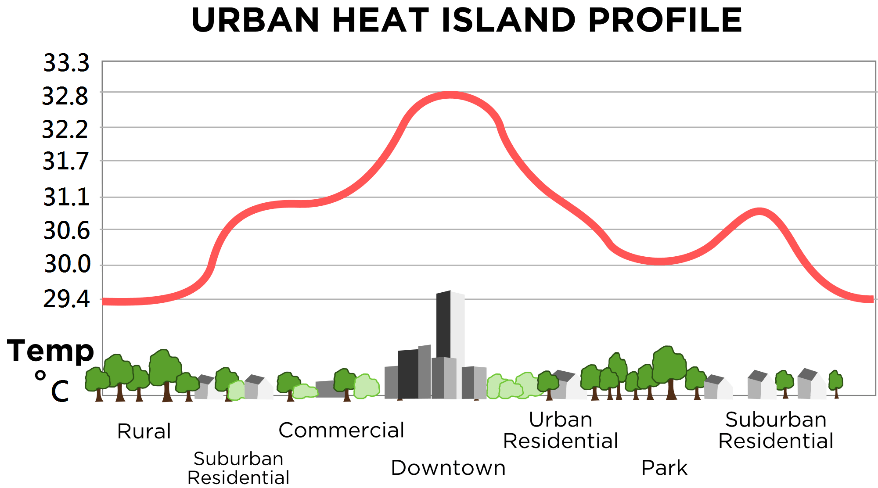By: Danelle Clavelle,
University of Saskatchewan student
As urbanization rises, it is becoming increasingly important that we are reducing our environmental impact and finding ways for our population and cities to become more sustainable. Urbanization is responsible for creating vast amounts of pollution and has a significant impact on the environment (Torrey). Urban areas consume more energy and release more heat than rural areas (Torrey). For example, Torrey states that “In China, the per capita consumption of coal in towns and cities is over three times the consumption in rural areas”. This concentrated heat and energy use creates heat islands over their city (Torrey). Heat islands have detrimental consequences on the environment; they cause the local and surrounding weather patterns to change and they trap atmospheric pollutants which result in increased air pollution (Torrey). Furthermore, cities emit more greenhouse gases and carbon dioxide than rural areas, have lower stormwater runoff quality and destroy wildlife habitats (Torrey).


Hafeez, Meral. Understanding the Urban Heat Island Effect.
A Potential Solution
It may seem like there is no hope for reducing the environmental impact cities have because our population and cities are ever-growing, but there is an unsung hero who can help! The kryptonite for urbanization pollution is green roofs. Green roofs have been found to reduce heat islands and carbon dioxide emissions, reduce energy use, provide a habitat for wildlife, reduce water runoff and can be used to produce food or as community spaces (“Using Green Roofs to Reduce Heat Islands”). There are two types of green roofs: Extensive Green Roofs and Intensive Green Roofs. Both can be used to mitigate the effects of urbanization and each provides different benefits which are described below (Grimwood).
Extensive Green Roofs

A guide to choosing between intensive and extensive green roof solutions
Extensive green roofs are built across a flat roof and have a thin layer of soil. Low maintenance and hardy plants are planted in the soil, such as grasses and succulents. These plants can absorb heat which helps cool the temperature of the building they’re on (Grimwood). The plant’s ability to absorb heat and cool a building reduces the amount of heat entering the atmosphere from the building (Grimwood). In some cities, temperatures on top of buildings can reach an astonishing 150 degrees Fahrenheit (Grimwood). Without any insulation on the building, such as green roofs, the heat will pass through the building right into the atmosphere, contributing to the heat island (Grimwood). Currently, air conditioning systems are used to help regulate the temperature of the building. However, using air conditioning is a waste of resources when we could be using green roofs to achieve the same result instead. Green roofs also absorb heat from the sun and surrounding air, which helps to further reduce the heat islands above the city (“Using Green Roofs to Reduce Heat Islands”). Lastly, plants can absorb the harmful pollutants in the atmosphere (“Using Green Roofs to Reduce Heat Islands”). Plants take in carbon dioxide, the primary greenhouse gas, and use it to perform biological functions like photosynthesis (“Using Green Roofs to Reduce Heat Islands”). The plant’s absorption of carbon dioxide and other harmful pollutants helps reduce air pollution and improve air quality in the city (“Using Green Roofs to Reduce Heat Islands”).
Intensive Green Roofs

Younkin, Eric. CEU: Green Roofs: Integrating Blue and Gray.
Intensive green roofs have a layer of soil several inches deep-laid across a flat roof. Intensive green roofs can be used for a variety of things. Fruits, vegetables, and other horticultural products can be grown on this type of green roof; or the green roof can be a leisure area for people to use. Raised garden beds can also be added to intensive green roofs to produce a more diverse range of products if so desired or to be used as community gardens. Intensive green roofs provide the same heat and pollutant absorption benefits as an extensive green roof, but intensive roofs also allow cities to grow local produce that can be used to feed their population or can be used as community spaces (Grimwood). Additionally, having vegetation on the rooftops helps local wildlife populations to flourish and reduces the impact the city has on their habitat (Grimwood). Many species of insects and birds have been found living on intensive green roofs (Grimwood).
Current Uses of Green Roofs

Balogh, Istvan. An intensive green roof over parking garage
Green roofs are becoming more popular and being used by cities around the world such as Chicago, Toronto, and Denver. Germany is leading the world in green roof development as they have the greenest roofs in the world (Mosyan). The USA has also become a large advocate for green roofs and is having green roofs constructed all over their country. Several major USA cities have created policies to promote the development of green roofs. In January 2018, a new decree took effect in Denver that requires new and old buildings larger than 25,000 square feet to have green roofs (Spiegel). Toronto has a similar bylaw that states new developments or additions to their city that are greater than 2,000 meters squared are required to have a green roof (“City of Toronto Green Roof Bylaw”.
Conclusion
As urbanization threatens our world with heat islands, increased pollution, wildlife destruction and more, green roofs present us with the opportunity to overcome these challenges. I propose a policy be made for cities to need to have a certain amount of their rooftops be green roofs and that new construction in the city must include plans to have green roofs on top of their buildings. This policy can include guidelines such as the city needing to be a certain size for this policy to be enforced, and that a percentage system is used to determine how many rooftops are to be converted. For example, the policy could state a city with 250,000 people would need to have 30% of their rooftops converted to green roofs. For a city with 500,000 people, 50% of the rooftops must be green roofs and all new development must have a green roof. The policy can also state that businesses will have until a specific year to convert their rooftop, and any rooftops converted within 2 years following the release of the policy will receive a bursary or grant from the government. Green roofs are an incredible tool that can be used to offset urbanization pollution, and it is our responsibility to use this tool to help us become more sustainable and ensure our planet is around for generations to come.
[su_accordion][su_spoiler title=”References” open=”no” style=”default” icon=”plus” anchor=”” class=””][su_list icon=”icon: check” icon_color=”#47907C”]
A guide to choosing between intensive and extensive green roof solutions. Interloc Building Solutions, interlocbuild.co.uk/a-guide-to-choosing-between-intensive-and-extensive-green-roof-solutions/. Accessed 30 Sept. 2020 (image).
City of Toronto Green Roof Bylaw. City of Toronto, toronto.ca/city-government/planning-development/official-plan-guidelines/green-roofs/green-roof-bylaw/. Accessed 20 Sept. 2020.
Grimwood, Mariah. Rooftop Gardens: Benefits for Energy Consumption. ECAVO, 31 Oct. 2019, ecavo.com/rooftop-gardens-energy-consumption/. Accessed 16 Sept. 2020.
Hafeez, Meral. Understanding the Urban Heat Island Effect. Lahore Conservation Society, lcs.org.pk/blog/understanding-the-urban-heat-island-effect/. Accessed 30 Sept. 2020. (image)
Luoma, Katie. How does population growth impact rapid urbanization? PopEd Blog, populationeducation.org/how-does-population-growth-impact-rapid-urbanization/. Accessed 30 Sept. 2020. (image)
Mosyan, Ani. Germany: State where green roofs are becoming part of architectural traditions. Youth for Exchange and Understanding International, 01 Jan. 2015, yeu-international.org/en/publications/newsmail/between-the-lines/germany-state-where-green-roofs-are-becoming-part-of-architectural-traditions#:~:text=Germany%20is%20the%20country%20with,and%20farm%20buildings%20in%20Iceland. Accessed 15 Sept. 2020.
Spiegel, Jan Ellen. Why rooftop gardens cool cities. Yale Climate Connections, 19 Mar. 2018, yaleclimateconnections.org/2018/03/why-rooftop-gardens-cool-cities/. Accessed 15 Sept. 2020.
Torrey, Barbara Boyle. Urbanization: an environmental force to be reckoned with. Population Reference Bureau, 23 Apr. 2004, prb.org/urbanization-an-environmental-force-to-be-reckoned-with/. Accessed 16 Sept. 2020.
Urbanization spurs a unique set of issues to both humans and animals. National Geographic, nationalgeographic.com/environment/habitats/urban-threats/. Accessed 16 Sept. 2020.
Using Green Roofs to Reduce Heat Islands. United States Environmental Protection Agency, epa.gov/heatislands/using-green-roofs-reduce-heat-islands. Accessed 15 Sept. 2020.
Younkin, Eric. CEU: Green Roofs: Integrating Blue and Gray. Building Enclosure, 30 May 2018, buildingenclosureonline.com/articles/87651-ceu-green-roofs-integrating-blue-and-gray. Accessed 30 Sept. 2020 (image)
Balogh, Istvan. Intensive green roof over parking garage. Alamy, 8 Nov. 2019, alamy.com/intensive-green-roof-over-parking-garage-multi-level-condominium-building-home-ownership-concept-friendly-neighborhood-yellow-and-red-autumn-trees-image343438601.html.
[/su_list] [/su_spoiler][/su_accordion]

Danelle Clavelle
Hi there! My name is Danelle Clavelle. I’m from Martensville, Saskatchewan and my family farms near Viscount, Saskatchewan. I’m in my fourth year of an Agribusiness Degree at the University of Saskatchewan. I decided to major in Agribusiness because I love agriculture and was inspired by my father who is a farmer and an Agricultural Economics grad from the University of Saskatchewan. After graduation, I hope to work for an agricultural firm, travel, and one day obtain my Commercial Pilots License! Some of my hobbies and interests include sports, aviation, travelling and reading.




